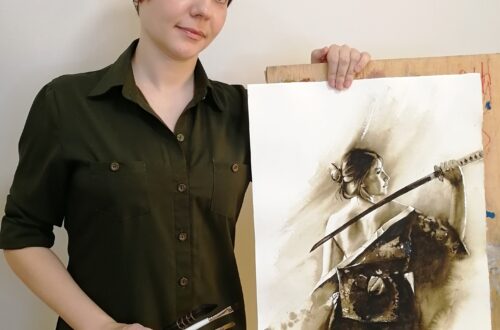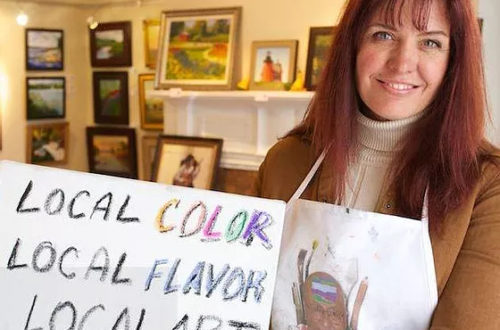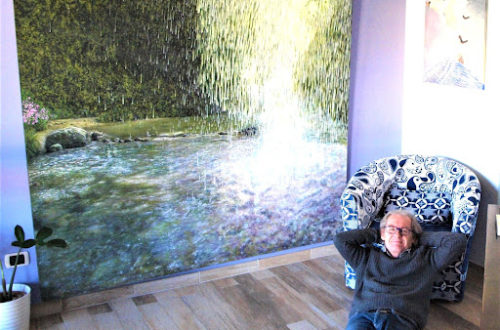Christian Shaknaitis is a sign-painter based in Pittsburgh, Pennsylvania. His business, Brush and Pounce, specializes in hand-painted signage and quality craftsmanship:
“My style reflects vintage signage, with a strong appreciation for the skilled craftsmanship of handmade signs of the past. The signs incorporate hand-painted, stylized and ornate type, hand-cut letters and elegantly finished wood panels.”
In addition to handfuls of businesses on Butler Street in the Lawrenceville neighborhood, his work is all over the city: including at The Abbey on Butler, Roberto Clemente Museum, Fox Chapel Ski and Board, Café D’Amore, Patagonia, Pittsburgh Burrito Bus and Pittsburgh Sandwich Society. I reached out to Christian to learn more about the revival of hand-painted signage and discover how we might connect the dots between members of the art supply community, the varied sign-painter types and people interested in learning the craft.
How did you get into sign-painting?
“I’ve been very interested in hand lettering and type for pretty much most of my life. My style of art pointed in the direction of sign painting, a traditional style, hand drawing. Working at various jobs, people would discover my talents and utilize them. I was working for a health food store in my hometown and they wanted new signage at their store. One sign led to two led to five, and then boom—we were doing signage for the whole store. The timing is a key part of my success: it seems that in the last several years there has been a revival of traditional style overall; handmade clothing, jewelry, soaps. With that comes hand painting, hand lettering: visuals that are more personal than a clip art file.”
What inspires you?
“The opportunity to create something that is my own, especially when I get to design from start to finish. I draw from traditional sign painting and lettering books from turn of the century up until mid century, as well as historical photos of old signage, and inspiration from many of my colleagues around the world. The business side I find most challenging and have learned a lot I never expected to. I just wanted to paint signs all day.”
Who do you work with and how do you connect with them?
“90% or more of the clientele I work with are small, independent business owners. People like me doing something they are passionate about. When I first started out in Pittsburgh, I was working at a bike shop. I mentioned sign painting, the owner asked me to do a sign. I met more people, and shops are opening up all over the place in Pittsburgh: coffeeshops, restaurants, boutiques. It’s a community of like-minded people, interested in what I am interested in.”

What does it mean to work with a sign-painter?
“A lot of people may not understand what kind of services a sign painter can offer. A shop might have minimum funds to have sign painting, and that tends to be the last thing on the list so it usually gets left off the table. It’s a process, from concept to design to completion. A sign painter will help you identify what’s most important and scale the price to your needs so that you still get something that gets people in the door.
One of the things I commonly say to clients when they are indecisive about what they want to do: having something hand-painted is going to make their business unique. Sometimes vinyl lettering does make sense, for instance for a small lettering project like hours of operation on a glass door.

But hand-painted signage, it’s a one of a kind thing. No other business is going to look the same. There could be thirty shops on a strip with hand-printed signage, but each one is going to be different: coloring, design, gilded, dimensional letters. Especially with gold leafing. Gold leafing is the top of the line; if a client decides to do a gold lettering thing, it says a lot, their customers realize that the business puts a lot into their work.”

What are the most rewarding aspects of your work?
- “One of the greatest things is showing up with the signage, delivering it, the client is the first person to see the finished work. The reaction is overwhelming: a big WOW. Hand-painted signage really completes the business.
- The hands on aspect. I do use a computer if I get a design for a client that’s not mine and need to do some rendering, but for the most part you still need to fabricate, paint, lay patterns… I feel more fulfilled by the hands on work.
- The community I am a part of, and learning is the other side of it.. I may have a method and set price, but then there will be another project that is complicated and pushes me to learn something new.”
How does social media play a role in your business?
“Social media has helped me immensely. I am old school, doing stuff long before Facebook, Instagram, even the internet. It blows my mind that twenty years ago when I was screen printing, I would have to go to shows, have merchandise, set up tables… now you don’t even have to leave your house but you can connect with people all over the world.”

“My Instagram is constantly updated; it is easy to do, a great portfolio for people to see my work, a great way to meet new clients.”

Sign-Painters: Artists or Mechanics?
Before our interview, I had read up on sign-painting quite a bit and discovered that historically, sign painters have considered themselves mechanics; the term “artist” wasn’t really an identifier. With hand-painted signs growing in popularity and legends like Mike Meyer traveling the country offering workshops, the need to categorize or “label” sign-painters has resurfaced. While the term sign-painter seems self-explanatory, there is so much more to the field, and the business, of sign-painting. Engineering. Mechanics. Construction. Artistry. Design. The debate around this terminology (which one am I? and if I choose one, is that limiting?) begs the question: how are we defining “artist” and when we market to artists, who are we leaving out? When I asked Christian for his thoughts, he took pause, thinking it through. The label of “artist” is a grey area he runs into frequently:
I don’t necessary consider myself an artist and when I say that, people scoff at me. But I think of someone who is doing fine art with sculpture or painting in a studio, showing in galleries. But the term mechanic…that resonates with me. Truthfully, it’s a combination of both. The visual aspect: sign painters try to make something appealing, which takes knowledge or art and design but then there is the implementation. Troubleshooting. When you get to the wall and realize, this is not going to work. I have to figure out how to do this. That engages the other side of the brain, the mechanic side. Sign painting is really a Jack-of-all-trades kind of work. I am by no means a woodworker, but I have some skills. I’ve fabricated signs, done basic routing, dabbled in different areas. That’s not saying that an ‘artist’ doesn’t have a wide range. But when people ask to show my work in a gallery, I say, drive down Butler Street, you’ll see 30+ pieces. It’s kind of like a permanent exhibit.
Understanding that for some of our customers, colleagues and partners, the street is their gallery and engineering and accounting are their side skills is a powerful shift in terms of understanding who falls into the broadening, complex identity of “artist.” How does sign-painting fit into the art supply community? How can we support, engage and inspire? With creatives like Christian Shaknaitis transforming city streets and taking initiative to grow the community through clubs, workshops and events, sign-painting is an industry that we can definitely work with. Read on to discover how you can utilize sign-painting in your business.







